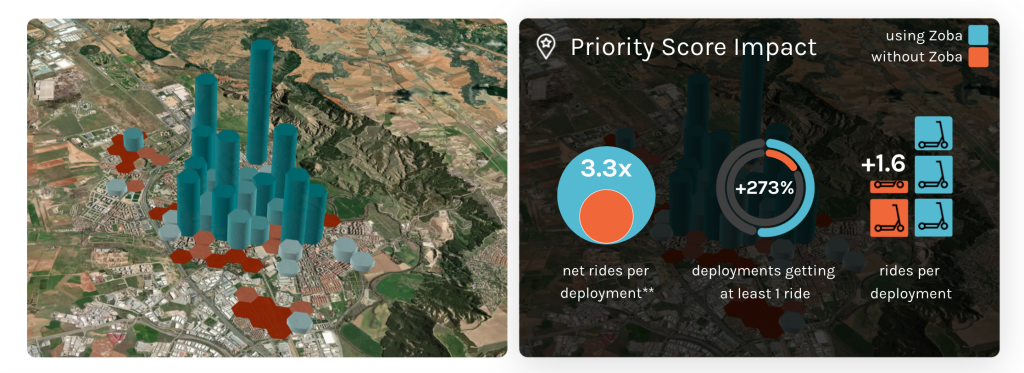There has been a huge shift in the priorities of shared operators over the last year. While previously it was all about growth, now it is how to make shared micromobility a sustainable business – how to be profitable.
The answer, according to Global fleet optimisation provider Zoba, is its new feature called Priority Scores.
“I really think this feature and some of the insights that it unlocks could be the thing that takes operators over the line into being able to run a profitable business,” Kate Grosch, Zoba’s Senior Product Manager, who is leading on the project, tells Zag Daily.
A Harvard grad, Grosch joined Zoba from Google where she owned the product strategy and roadmap for bidding optimisation, directly contributing $500m of growth to the $14bn display ad business.
“I was working specifically in ads optimisation, deep in automated bidding, which is behind all digital ads that you see on the internet,” says Grosch. “After Google, I really wanted to work somewhere where there were still a lot of data science problems to solve.”
That is how she landed on the micromobility industry.
“Micromobility is where ads were like 20 years ago. In 2003 marketers would place an advert in say the New York Times and make these very manual decisions about the right places to put them. Over the last 20 years there’s been a massive shift towards more automation. Being able to use really complex ML to place ads at the right place at the right time at the right price, leaving marketers to do more of the creative work that they’re really good at.
“Today in micromobility you have city managers spending a lot of their time doing things computers could do better like deciding where specific demand is at a specific time and how that might change if the temperature goes up by five degrees, and then not being able to spend time on the things humans are much better at, such as managing their workforce or working with city regulators. So making that transition was like going back in time, but being able to solve a lot of those same problems.”
One such problem Kate’s team at Zoba noticed was that, while their recommendations were valuable for clients they work with, city managers often want more specific, granular insights.
“City managers constantly have to make hard choices about how to fill their day. There are a million things to do with regulatory compliance and placing scooters where they’re going to get rides and swapping batteries. What we heard is that it was really hard to know which tasks are going to give them the most impact.”
Priority Scores
Priority Scores is a specific score that Zoba calculates during optimisation that tells a city manager how many rides or how much revenue they can get by taking a specific action in their market. That action could be a deployment or a rebalance or battery swap.
This makes it easy for operators to make informed tradeoffs quickly.
Using Priority Scores, operators can do things like identify the best specific vehicles to rebalance right now, calculate operational impact by shift, and compare demand levels and performance across neighbourhoods.
“The feature allows operators working on the razor edge of profitability to choose the things that will get them over the line to profitability, whether that’s driving an extra 20 minutes to do a deployment because it’s going to get them an extra ride, or doing more swaps because you’re already in the area.”

At a higher level, priority scores make it easier for larger operators to compare markets and better calculate the optimal fleet size for a given city to ensure they are maximising the ROI of their investments.
Real world impact
Zoba is currently testing the feature with three clients and already seeing significant lift in a short space of time.
“The most exciting analysis we have done so far is the testing for one client where we can see their top 100 stations they are using to drop vehicles and the average priority score at each of these stations over the past month. We see this beautiful descending curve which shows your best station gets you 5.6 rides, then 4.1 rides, and draw a line across and say we’re going to cut these stations that are not profitable. So operators can right-size their fleet for the stations that constantly get them the dollars they need.”
The company is so confident in its product that it guarantees at least 10% improvement on a city manager’s deployment efficiencies over the course of a year.
Moving out of the beta phase, the feature is due to be turned on for all Zoba’s clients over the next two to three weeks.
“We also have some exciting updates on our roadmap around the different ways we can incorporate these scores into more holistic insights for customers. So for instance, how demand is flowing in the market or where particular drive routes might be able to capture the most demand.
“Ultimately, our aim is to use these scores as a fundamental building block for better market insights across the city. It is incredibly exciting as we believe this tool can really help us close that 20 year gap on the ads industry.”



